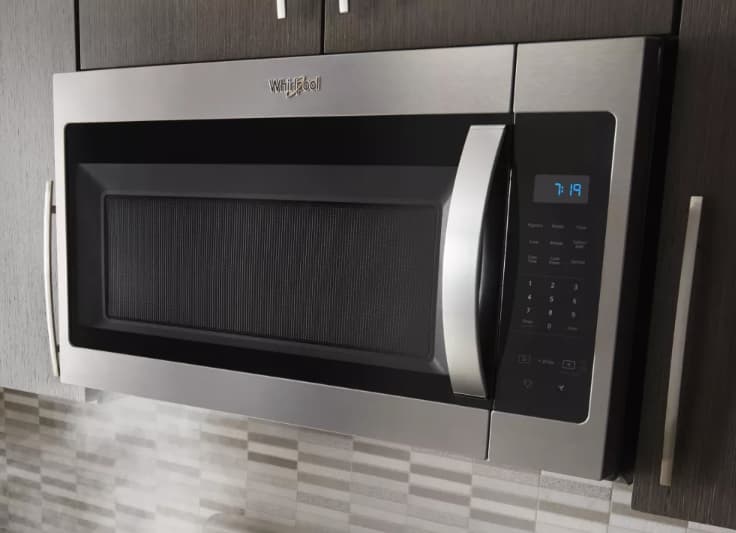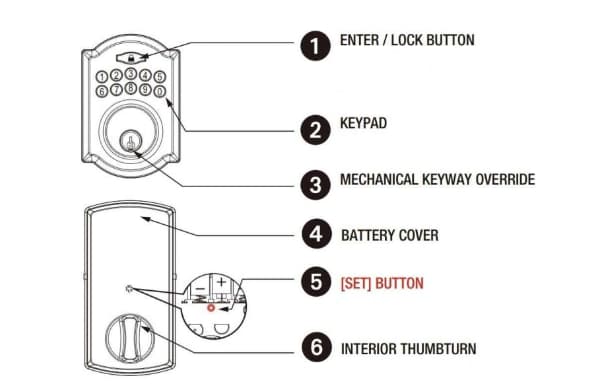Facing the SPD2 error on your Whirlpool microwave?
Dive into this comprehensive guide to not only understand the root causes behind this persistent fan issue but also discover step-by-step troubleshooting methods.
From basic checks to in-depth solutions, arm yourself with the knowledge to address the problem efficiently. Plus, glean preventive measures to ensure your appliance runs smoothly in the future.
Whether you’re a DIY enthusiast or someone seeking clarity before calling in the pros, this post has you covered.
An enigmatic issue has been perplexing Whirlpool microwave owners recently: the fan that just won’t turn off, even flagged by the SPD2 error code.
While this may seem trivial to some, it’s imperative to address this hiccup expediently, ensuring both safety and efficiency in the kitchen.
Whirlpool Microwave Fan Won’t Turn Off SPD2

Key Takeaways:
- The SPD2 error indicates an issue with the Whirlpool microwave’s fan system.
- Root causes can include malfunctioning door switches, ventilation blockages, or control board anomalies.
- Immediate implications of the error include increased energy consumption, potential microwave lifespan reduction, and safety concerns.
- Basic troubleshooting involves checks like ensuring the proper door latch, resetting the microwave, and inspecting the control panel.
- In-depth solutions include cleaning the ventilation system, inspecting the fan motor, checking the control board, examining the thermostat, and addressing door switch issues.
- Utilizing the right set of tools is crucial for successful DIY troubleshooting.
- Preventive measures such as regular cleaning, using surge protectors, and adhering to usage guidelines can mitigate future errors.
- Recognizing when to call professionals is essential for intricate issues.
Understanding the Whirlpool Microwave
Microwaves, those marvels of modern kitchen technology, have brought convenience into our homes, allowing for expedited meal preparations. The unheralded hero within this mechanism is, surprisingly, the fan. This component plays an integral role in not only dispersing heat but also aiding in the cooking of your delectables.
Decoding the SPD2 Error
The SPD2 error, particularly in the context of Whirlpool microwaves, signifies a problem not to be ignored. Decoding this error gives owners a headstart in troubleshooting and taking corrective measures. Let’s dive into understanding this error more comprehensively.
- Nature of SPD2 Error: At its core, the SPD2 error signals an anomaly with the fan system. This could mean the fan won’t stop running even after the cooking cycle has been completed.
- Triggers for the Error: While the immediate concern is the continuously running fan, the root causes can vary. It could be triggered by:
- A malfunctioning door switch, makes the system believe the microwave is still in operation.
- Blockages in the ventilation system, cause the microwave to overheat and the fan to continually operate in an attempt to cool the system down.
- Issues with the control board, causing incorrect signals to be sent to the fan.
- Identifying the Error: Most modern microwaves, including those from Whirlpool, come with a digital display. The SPD2 error typically manifests itself as an alphanumeric code on this display.
- Immediate Implications: If left unaddressed, the SPD2 error can:
-
- Increase energy consumption due to the continuous running of the fan.
- Potentially shorten the lifespan of the microwave, with the fan motor being overworked.
- Raise safety concerns due to potential overheating.
- Rectification Path: Before jumping into deep fixes, understanding the error is crucial. With this knowledge:
- Owners can undertake basic troubleshooting, from checking for obstructions to resetting whirlpool microwave.
- If basic measures don’t resolve the issue, in-depth fixes like inspecting the fan motor or control board become necessary.
Significance of the Microwave Fan
Beyond its role in culinary perfection, the fan plays a paramount role in the microwave’s overall health. It ensures that your food receives uniform heat, thus avoiding those ice-cold centers in reheated meals. Furthermore, by facilitating heat dispersion, the fan indirectly prolongs your appliance’s lifespan, safeguarding your investment.
Dangers of an Always-On Fan
An incessantly running fan is not just a trifling annoyance. It’s a silent energy guzzler, incrementally inflating utility bills. There’s also the looming threat of overheating, which could metamorphose into a safety hazard. Moreover, constant operation inadvertently accelerates wear and tear, diminishing the longevity of the microwave.
Immediate Measures to Take
The moment you recognize the SPD2 error, it’s prudent to unplug the microwave. This isn’t just about preventing further complications—it’s a foundational safety protocol. Remember, with electrical appliances, safety always reigns supreme.
Basic Troubleshooting Before the Deep Dive
- Check Door Latch: Ensure it’s securing properly when closed.
- Reset the Microwave: Unplug and plug it back in or use the designated reset function.
- Inspect Control Panel: Look for visible damages or other error codes.
- Listen for Unusual Noises: Sudden grinding or humming can indicate internal issues.
- Confirm Power Supply: Ensure the microwave is receiving consistent power without interruptions.
- Test Different Settings: See if the error is consistent across all functions or specific to one.
- Examine External Vents: Ensure they are not obstructed or excessively dirty.
- Review User Manual: Refer to the troubleshooting section specific to your model.
- Temperature Check: Feel for unusual heat spots on the microwave exterior.
- Ensure Door Seal: Make sure the seal is intact and there are no gaps when closed.
In-depth Fixes for SPD2 Error
-
Clean the Ventilation System
A congested vent is often synonymous with reduced airflow, potentially triggering the SPD2 error. Therefore, a meticulous cleaning is not just recommended—it’s quintessential. Roll up those sleeves and follow a systematic cleaning regimen to ensure unimpeded airflow.
-
Inspect the Fan Motor
Every mechanical component has a finite life, the fan motor being no exception. Symptoms of its decrepitude can manifest in unusual noises or inconsistent speeds. Delve into the microwave’s innards, access the motor, and make a judicious call on whether a replacement is in order.
-
Check the Microwave Control Board
Consider this the microwave’s cerebral cortex—a nexus of electrical pathways and commands. Erratic behavior, like the relentless fan, could stem from a rogue control board. While a total reset might be the panacea, be on the lookout for any blatant signs of damage.
-
Examine the Thermostat
The thermostat, that vigilant sentinel, ensures temperatures remain within optimal bounds. If it’s misreading the internal climate, it could erroneously keep the fan engaged. Differentiating between a malfunction and a mere calibration issue is pivotal here. Sometimes, a replacement might be the most judicious route.
-
Door Switch Troubles
The humble door switch acts as a sentinel, determining when certain components, like the fan, should engage or disengage. A malfunctioning switch might fail to “inform” the fan to cease operations. Pinpointing a faulty switch and subsequently replacing it can often alleviate the SPD2 conundrum.
Tools You’ll Need for the Fixes
Embarking on a mission to fix your microwave, especially when confronting the SPD2 error, requires not just fortitude but also the right set of tools.
Ensuring you have these tools at your disposal not only eases the repair process but also ensures safety and precision.
Let’s delve into the essential toolkit you should arm yourself with:
- Screwdrivers: A comprehensive set, spanning various sizes and types (Phillips and flat-head), is indispensable. These are quintessential for opening up the microwave and accessing internal components.
- Needle-nose pliers: These are crucial for gripping small components or wires within the microwave. Their slender shape allows for precision handling in cramped spaces.
- Multimeter: An electrical measuring device, a multimeter is vital when you’re gauging the health of various electronic components. It can measure voltage, resistance, and current, helping you pinpoint if a part is faulty.
- Non-contact voltage tester: Safety is paramount when working with electrical appliances. This tool allows you to ascertain if there’s residual electricity within the microwave, ensuring you don’t get an unexpected shock.
- Torx screwdrivers: Some microwave models have special screws that can’t be tackled with conventional screwdrivers. A set of Torx screwdrivers ensures you’re prepared for any screw type.
- Wire stripper: In scenarios where you might need to replace or reconnect a wire, this tool is essential for safely stripping away insulation without damaging the wire.
- Flashlight or headlamp: Microwaves can be dark on the inside, especially in those hard-to-reach corners. A good light source ensures you see what you’re doing and prevents any mishaps.
- Safety gloves: Given that you’ll be dealing with electrical components and metal edges, a sturdy pair of non-conductive gloves will protect your hands from cuts, burns, or electrical shocks.
- Safety goggles: When delving into the microwave’s innards, tiny particles or debris can become airborne. Safety goggles protect your eyes and ensure clear vision during the process.
- Circuit pen: Handy for marking or labeling various connections or components, ensuring you remember where everything goes when it’s time to reassemble.
- Zip ties or twist ties: If you happen to disturb the internal wiring, these ties help in neatly bundling them together, ensuring they don’t interfere with other parts.
- Digital camera or smartphone: Before disassembling anything, it’s wise to snap photos of the original setup. This becomes a valuable reference, ensuring you reassemble everything correctly.
Equipped with this comprehensive toolkit, you’re not only poised to tackle the SPD2 error but a myriad of other potential microwave maladies. Remember, while the right tools can make the task significantly easier, always prioritize safety and consult your microwave’s manual before starting any repairs.
Preventive Measures to Avoid Future SPD2 Errors
- Regular Cleaning: Ensure the microwave, especially the ventilation system, is cleaned routinely to prevent debris accumulation which can strain the fan.
- Use Surge Protectors: Protect the microwave from potential electrical surges by using a reliable surge protector.
- Dedicated Circuit: If possible, ensure the microwave is connected to a dedicated electrical circuit to minimize the risks of power inconsistencies.
- Adhere to Usage Guidelines: Always follow the manufacturer’s guidelines, such as:
- Not running the microwave empty.
- Ensuring even food distribution for consistent heating.
- Using microwave-safe containers.
- Monitor Door Seals: Ensure the microwave door seals properly. A compromised seal can impact the fan’s functionality.
- Avoid Overloading: Overstuffing the microwave can lead to uneven heat distribution and place unnecessary strain on the fan.
- Regular Component Checks: Periodically inspect the fan motor, door switches, and other integral components for wear and tear. Replace them if needed before they cause errors.
- Ventilation Clearance: Make sure the microwave has adequate clearance for ventilation around it. This aids in preventing overheating.
- Avoid Power Interruptions: Try not to abruptly cut power to the microwave. Instead, let it complete its cycle or use the stop/cancel button.
- Update Software/Firmware: If your microwave has smart features, ensure its software or firmware is regularly updated, as some errors can be fixed with software patches.
Implementing these measures can help significantly reduce the likelihood of encountering the SPD2 error and ensure your microwave’s optimal operation for years to come.
Replacing Parts: OEM vs. Generic
In the perennial debate between OEM (Original Equipment Manufacturers) and generic parts, one must consider both longevity and cost-effectiveness. While OEM parts promise compatibility and durability, some generic variants offer commendable quality without the hefty price tag.
When to Call in the Professionals
No matter the depth of your DIY prowess, there are moments when the experts need to step in. If the issue appears labyrinthine or if the microwave behaves erratically post your interventions, it’s sagacious to call in professionals.
Conclusion
While the SPD2 error can be daunting, armed with the right knowledge and a smidgeon of patience, it’s wholly surmountable. Always prioritize safety, ensure regular maintenance, and remember: that proactive care is the cornerstone of a long-lasting appliance.
Further Reading and Resources
- Dive into Comprehensive Manuals: Official Whirlpool Microwave Manuals
- Engage with Community Forums: https://producthelp.whirlpool.com/
- Specialized Courses: https://www.coursera.org/learn/microwave-antenna
Remember, knowledge is the ultimate power tool.



